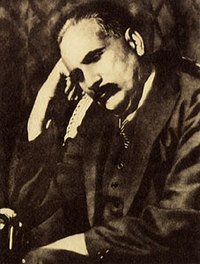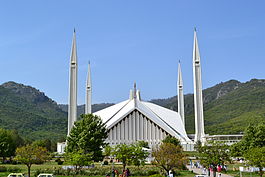Nathia Gali
Nathia Gali or Nathiagali (Pashto: نتھیا گلی, Urdu: نتھیا گلی) is a mountain resort town or hill station in Hazara, Khyber Pakhtunkhwa, Pakistan. It is a part of the Galyat range, where several hill-stations are situated, closely connected to each other, and with their names mostly ending in 'Gali'. Nathiagali is known for its scenic beauty, hiking tracks and pleasant weather, which is much cooler than the rest of the Galyat due to it being at a greater altitude. It is situated 34 kilometers at one hour's drive away from both Murree and Abbottabad, lying midway between these two places. The drive time from Islamabad is usually about two hours, unless there is a lot of traffic.
During British rule Nathia Gali, then part of Abbottabad tehsil of Hazara District, served as the summer head-quarters of the Chief Commissioner of the (then) Peshawar division of the Punjab.The town along with Dunga Gali constituted a notified area under the Punjab Municipalities Act, 1891. The income in 1903-4 was Rs. 3,000, chiefly derived from a house tax, whilst expenditure was Rs. 1,900.The weather of Nathiagali remains cool, pleasant and foggy in Summers (1 May to 31 August). During the Monsoon season (1 July to 16 September), rain is expected almost every day. Cold winds start to chill the weather in Autumn. Winters (1 November to 28 February) are very cold and chilly. In December and January, heavy snowfall occurs here. The weather remains cold in Spring. Here most comfortable weather is the summer season.
A beautiful hotel in Nathia Gali
Tourism:
Nathia Gali town also serves as the administrative centre of Nathia Gali Union Council. It is today located in what is the Abbottabad District, Khyber Pakhtunkhwa. At 2,500 m (8,200 ft), it is a popular tourist resort in the summer months. It is forested with pine,cedar,oak walnut and also oak and maple trees.During the summer, Nathia Gali is relatively popular amongst tourists, but due to its limited size and availability of property, it is not thronged by as many people as the hill-station Murree, which is only an hour away, even though it has more to offer in terms of nature.

The Nathiagali region is home to various species of birds, insects, butterflies and other animals. The World Wildlife Fund has an office in the Galliat and has assisted in the breeding and reintroduction of the species of the near-extinct Common Hill Leopard in the forests of the Ayubia National park, right by Dungagali and Nathiagali. This area was thought to be a perfect habitat for them but according to local reports they frequently came out of the forest after cattle of the local villagers and were occasionally shot. Packs of pi-dogs which were previously considered to be a night-time menace can no longer be seen anywhere in the Galliat; it is thought that most have been killed by leopards. In the summer of 2006, several women were found dead in the deep valleys of Galliat with wounds from attacks. A large leopard was caught and eventually shot. His body has been stuffed and kept in the Dunga Gali Wildlife Museum, where he has been named the 'Ghost of Galyat'. However, despite their reputation, these leopards are rarely spotted.
Horses are a common sight during summer months and are offered to children and adults alike for rides at rates that are often negotiable. The common hill Rhesus Monkeys can often be seen. Previously known to be a little shy, they have reportedly become more aggressive in recent years. This may be due to increased interaction with tourists, who often tease these monkeys or try to catch them. Monkeys often come up to guesthouses and hotels in search of snacks and can be quite noisy and playful. Visitors are advised to sun their bedding on arrival to get rid of bed-bugs, and to keep repellants and pesticides for insects as these have a tendency to show up a lot, especially in old homes, and in the monsoon season.












